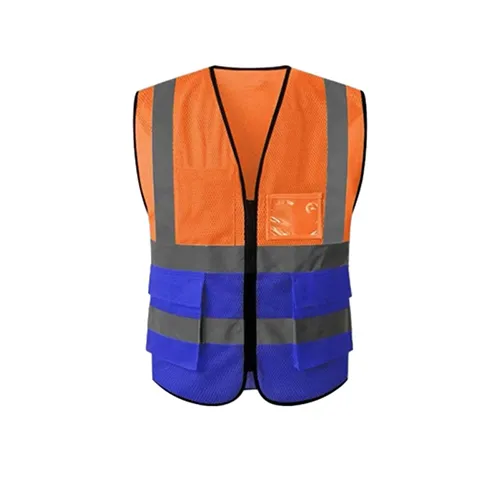+8615630398555
- Afrikaans
- Albanian
- Arabic
- Armenian
- Basque
- Belarusian
- Bengali
- Bulgarian
- Croatian
- Czech
- Danish
- Dutch
- English
- Esperanto
- Finnish
- French
- German
- Greek
- Hebrew
- Hindi
- Indonesian
- irish
- Italian
- Japanese
- Javanese
- kazakh
- Rwandese
- Korean
- Kyrgyz
- Latin
- Latvian
- Luxembourgish
- Malay
- Myanmar
- Nepali
- Persian
- Polish
- Portuguese
- Romanian
- Russian
- Serbian
- Slovak
- Spanish
- Swedish
- Tagalog
- Tajik
- Turkish
- Ukrainian
- Uzbek
- Vietnamese
Feb . 15, 2025 21:48 Back to list
construction workwear clothing
Visibility vests, often referred to as high-visibility vests or hi-vis vests, are an integral part of personal protective equipment (PPE) widely used across various industries. Their primary purpose is to ensure that individuals are easily seen in environments where visibility is crucial for safety. As an essential piece of safety gear, visibility vests are designed with highly reflective materials that shine under light, making the wearer conspicuous in low-visibility conditions.
When selecting a visibility vest, several factors must be considered to ensure the appropriate choice is made. The environment in which the vest will be used plays a significant role in determining the type of vest required. For instance, a construction worker operating at night on a busy highway would require a vest rated as Class 3 to ensure maximum visibility. The comfort and fit of the vest are also vital, as they affect the wearer's mobility and willingness to wear the vest consistently. Breathable materials and adjustable features enhance comfort, enabling workers to perform their tasks without restriction. Visibility vests are not just about meeting regulatory compliance; they are about fostering a culture of safety. Companies investing in high-quality visibility vests demonstrate a commitment to their employees' well-being. By prioritizing safety, organizations build trust among their workforce, reduce the occurrence of workplace accidents, and enhance overall productivity. This not only benefits the company and its workers but also improves public perception. In addition to traditional industries, visibility vests have found applications in recreational activities such as cycling and running. Individuals who engage in these activities often wear visibility vests to ensure they remain visible to drivers, especially in low-light conditions. The growing trend of increasing safety awareness has led to more individuals incorporating visibility vests into their daily activities. In conclusion, the significance of visibility vests cannot be understated. As an essential component of PPE, they offer a simple yet effective solution to the multifaceted challenge of ensuring safety in environments where visibility is a concern. From their design and regulatory compliance to their practical application across various sectors, visibility vests embody the principles of safety, reliability, and innovation. By understanding and utilizing visibility vests effectively, organizations and individuals alike can mitigate risk, enhance safety, and promote a secure working and recreational environment.


When selecting a visibility vest, several factors must be considered to ensure the appropriate choice is made. The environment in which the vest will be used plays a significant role in determining the type of vest required. For instance, a construction worker operating at night on a busy highway would require a vest rated as Class 3 to ensure maximum visibility. The comfort and fit of the vest are also vital, as they affect the wearer's mobility and willingness to wear the vest consistently. Breathable materials and adjustable features enhance comfort, enabling workers to perform their tasks without restriction. Visibility vests are not just about meeting regulatory compliance; they are about fostering a culture of safety. Companies investing in high-quality visibility vests demonstrate a commitment to their employees' well-being. By prioritizing safety, organizations build trust among their workforce, reduce the occurrence of workplace accidents, and enhance overall productivity. This not only benefits the company and its workers but also improves public perception. In addition to traditional industries, visibility vests have found applications in recreational activities such as cycling and running. Individuals who engage in these activities often wear visibility vests to ensure they remain visible to drivers, especially in low-light conditions. The growing trend of increasing safety awareness has led to more individuals incorporating visibility vests into their daily activities. In conclusion, the significance of visibility vests cannot be understated. As an essential component of PPE, they offer a simple yet effective solution to the multifaceted challenge of ensuring safety in environments where visibility is a concern. From their design and regulatory compliance to their practical application across various sectors, visibility vests embody the principles of safety, reliability, and innovation. By understanding and utilizing visibility vests effectively, organizations and individuals alike can mitigate risk, enhance safety, and promote a secure working and recreational environment.
Next:
Latest news
-
Work Reflective Vest: A Silent Guardian of Security
NewsJul.10,2025
-
Vest Reflective Safety: A Safety Lighthouse in Low Light and High Traffic Environments
NewsJul.10,2025
-
Soft Cotton Polo Shirts: A Fashionable and Practical Choice for Multiple Scenarios
NewsJul.10,2025
-
Soft Cotton Polo Shirts: A Fashionable and Practical Choice for Multiple Fields
NewsJul.10,2025
-
Reflective Vest: The Light of Industry and Outdoor Safety Protection
NewsJul.10,2025
-
Polo Shirt: A versatile and fashionable item that can be worn in one outfit
NewsJul.10,2025
Copyright © 2025 Handan Xinda Qihang Trading Co., Ltd. All Rights Reserved. Sitemap | Privacy Policy




